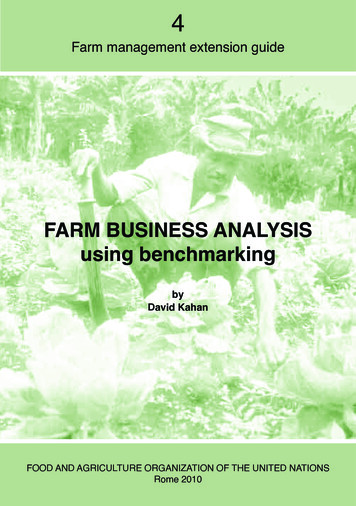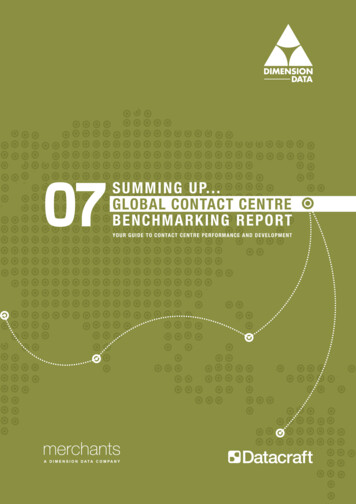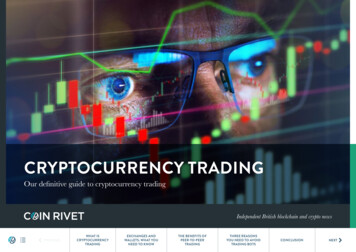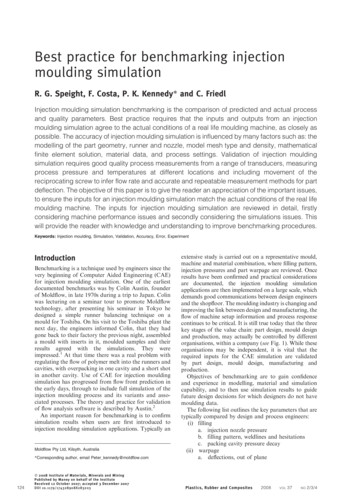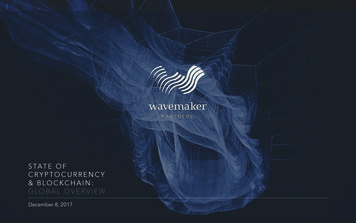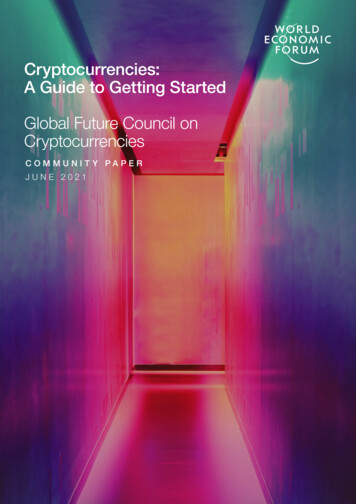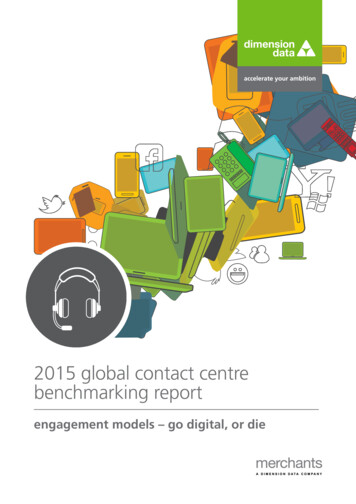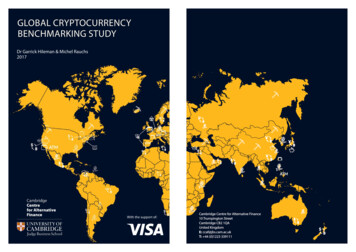
Transcription
GLOBAL CRYPTOCURRENCYBENCHMARKING STUDYDr Garrick Hileman & Michel Rauchs2017With the support of:Cambridge Centre for Alternative Finance10 Trumpington StreetCambridge CB2 1QAUnited KingdomE: ccaf@jbs.cam.ac.ukT: 44 (0)1223 339111
Global Cryptocurrency Benchmarking StudyCONTENTSFOREWORDS2RESEARCH TEAM4ACKNOWLEDGMENTS5EXECUTIVE SUMMARY8METHODOLOGY AND STUDY STRUCTURE9GLOSSARY10SETTING THE DICES104REFERENCES AND ENDNOTES1081
ForewordsFOREWORDSThe world of money and finance is transforming before our eyes. Digitised assets andinnovative financial channels, instruments and systems are creating new paradigms forfinancial transaction and forging alternative conduits of capital. The Cambridge Centre forAlternative Finance, since its founding in 2015, has been at the forefront of documenting,analysing and indeed critically challenging that digital financial transformation.This Global Cryptocurrency Benchmarking Study is our inaugural research focused onalternative payment systems and digital assets. Led by Dr Garrick Hileman, it is the first studyof its kind to holistically examine the burgeoning global cryptocurrency industry and its keyconstituents, which include exchanges, wallets, payments and mining.The findings are both striking and thought-provoking. First, the user adoption of variouscryptocurrencies has really taken off, with billions in market cap and millions of walletsestimated to have been ‘active’ in 2016. Second, the cryptocurrency industry is bothglobalised and localised, with borderless exchange operations, as well as geographicallyclustered mining activities. Third, the industry is becoming more fluid, as the lines betweenexchanges and wallets are increasingly ‘blurred’ and a multitude of cryptocurrencies, not justbitcoin, are now supported by a growing ecosystem, fulfilling an array of functions. Fourth,issues of security and regulatory compliance are likely to remain prevalent for years to come.I hope this study will provide value to academics, practitioners, policymakers and regulatorsalike. We thank Visa very much for its generous support of independent academic research inthis important area.Bryan ZhangCo-founder and Executive Director (Interim)Blockchain has received a significant amount of analyst and press attention over the last fewyears as this emerging technology holds significant potential. Use cases are many and varied:ranging from programmable cryptocurrencies to property deeds management to provenancetracking to voting records.Cryptocurrencies were the first application of this technology, and in doing so introducedan entirely new set of businesses, jobs and vocabulary to the world of payments. Visa hasbeen exploring the impact of these technologies to determine how this new ecosystem willcontinue to grow and evolve.Amongst all the excitement and enthusiasm in the press there has also been some hyperbole,and any efforts to provide a realistic snapshot of the industry should be welcomed. Visawelcomes opportunity to sponsor research from a respected organisation, the Judge BusinessSchool at Cambridge University, which we trust, the reader will find objective, informativeand insightful.Jonathan VauxVP, Innovation & Strategic Partnerships2
Global Cryptocurrency Benchmarking StudyIt is my great pleasure to present the first global cryptocurrency benchmarking study. Thefindings from our study are based on the collection of non-public data from nearly 150companies and individuals, and this report offers new insights on an innovative and rapidlyevolving sector of the economy.Cryptocurrencies such as bitcoin have been seen by some as merely a passing fad orinsignificant, but that view is increasingly at odds with the data we are observing. As of April2017, the combined market value of all cryptocurrencies is 27 billion, which represents alevel of value creation on the order of Silicon Valley success stories like AirBnB. The advent ofcryptocurrency has also sparked many new business platforms with sizable valuations of theirown, along with new forms of peer-to-peer economic activity.Next year will mark the ten-year anniversary of the publication of Satoshi Nakamoto’s paperdescribing how a new digital financial instrument could be created and operated securelywith a blockchain. The growing usage and range of capabilities we document in this studyindicate that cryptocurrencies are taking on an ever more important role in the lives of agrowing number of people (and machines) around the world. As we show in this study, thenumber of people using cryptocurrency today has seen significant growth and rivals thepopulation of small countries.By our count, over 300 academic articles have been published on various aspects of bitcoinand other cryptocurrencies over the past several years. However, these works tend to takea narrow focus. To our knowledge this is the first global cryptocurrency study based on nonpublic ‘off-chain’ data. We designed the study to present an empirical picture of the currentstate of this still maturing industry, and to explore how cryptocurrencies are being usedtoday. The findings from this study will be useful to industry, academics, policymakers, media,and anyone seeking to better understand the cryptocurrency landscape.This study would not have been possible without the support and participation from nearly150 cryptocurrency companies and individuals that contributed data, many of which haveelected to have their logos displayed in this report. This study also greatly benefitted fromsuggestions and support we received from many individuals and firms we recognise inthe Acknowledgements. We are grateful for the trust placed by study participants in theUniversity of Cambridge research team.We are looking forward to continuing and expanding our cryptocurrency and blockchainresearch program. In a few weeks, we will also be publishing the results of a separate studyfocused on the use of distributed ledger technology (DLT), which examines the use of DLTby more established industry players as well as at public sector institutions such as centralbanks.Thank you for your interest in this study. We will be conducting these benchmarking studieson an annual basis, and I welcome your comments and feedback.Garrick Hilemang.hileman@jbs.cam.ac.uk3
Research TeamRESEARCH TEAMDR GARRICK HILEMANDr Garrick Hileman is a Senior Research Associate at theCambridge Centre for Alternative Finance and a Researcherat the Centre for Macroeconomics. He was recently rankedas one of the 100 most influential economists in the UKand Ireland and he is regularly asked to share his researchand perspective with the FT, BBC, CNBC, WSJ, Sky News,and other media. Garrick has been invited to present hisresearch on monetary and distributed systems innovation togovernment organisations, including central banks and warcolleges, as well as private firms such as Visa, Black Rock, andUBS. Garrick has 20 years’ private sector experience withboth startups and established companies such as Visa, Lloyd’sof London, Bank of America, The Home Depot, and Allianz.Garrick’s technology experience includes co-founding a SanFrancisco-based new venture incubator, IT strategy consultingfor multinationals, and founding MacroDigest, which employsa proprietary algorithm to cluster trending economic analysisand perspective.MICHEL RAUCHSMichel Rauchs is a Research Assistant at the Cambridge Centrefor Alternative Finance. Cryptocurrencies and distributedledger technologies have been the topic of his academicstudies for the last two years, and his Master’s thesis visualisedthe evolution of the Bitcoin business ecosystem from 20102015 using a unique longitudinal dataset of 514 companiesand projects. He holds a Bachelor in Economics from HECLausanne and recently graduated from Grenoble Ecole deManagement with a Master’s degree in International Business.4
Global Cryptocurrency Benchmarking StudyACKNOWLEDGMENTSWe would like to thank the Asia Blockchain Foundation, 8btc.com, Coin Center, CoinDesk, The Coinspondent and ther/bitcoin forum on Reddit for helping to build awareness and supporting the study.We would also like to specifically thank Jelena Strelnikova (Asia Blockchain Foundation), Neil Woodfine (Remitsy), DaveHudson (PeerNova), Philip Martin and David Farmer (Coinbase), Peter Smith (Blockchain), Jez San, Jon Matonis (Globitex/Bitcoin Foundation), Roger Ver (Bitcoin.com), Jill Carlson (Chain), Christopher Harborne, Sveinn Vallfels (Flux), CathyLige, Jonathan Levin and Michael Gronager (Chainalysis), George Giaglis (Athens University of Economics and Business),George Papageorgiou (University of Nicosia), Vitalii Demianets (Norbloc) and CoinATMRadar for their generous help andassistance throughout the research process.Special thanks go also to Alexis Lui, Alex Wong and Hritu Patel (Judge Business School) for the design of this study.Finally, we would like to express our gratitude to Kate Belger, Hungyi Chen, Raghavendra Rau, Nia Robinson, RobertWardrop, Bryan Zhang and Tania Ziegler of the CCAF for their continued support and help in producing this report.Special thanks also go to Jack Kleeman.5
AcknowledgmentsWe would like to thank the following cryptocurrency organisations for participating and contributing to this research study:1CMYK6
Global Cryptocurrency Benchmarking StudySatoshiTango7
Executive SummaryEXECUTIVE SUMMARYThis is the first study to systematically investigate key cryptocurrency industry sectors by collecting empirical, non-public data.The study gathered survey data from nearly 150 cryptocurrency companies and individuals, and it covers 38 countries from fiveworld regions. The study details the key industry sectors that have emerged and the different entities that inhabit them.KEY HIGHLIGHTS OF THE STUDY The current number of unique active users of cryptocurrency wallets is estimated to be between 2.9 million and 5.8 million. The lines between the different cryptocurrency industry sectors are increasingly blurred: 31% of cryptocurrency companiessurveyed are operating across two cryptocurrency industry sectors or more, giving rise to an increasing number of universalcryptocurrency companies. At least 1,876 people are working full-time in the cryptocurrency industry, and the actual total figure is likely well above twothousand when large mining organisations and other organisations that did not provide headcount figures are added. Average security headcount and costs for payment companies and exchanges as a percentage of total headcount/operatingexpenses are similar, but significantly higher for wallets.EXCHANGES The exchanges sector has the highest number of operating entities and employs more people than any other industry sectorcovered in this study; a significant geographical dispersion of exchanges is observed. 52% of small exchanges hold a formal government license compared to only 35% of large exchanges. On average, security headcount corresponds to 13% of total employees and 17% of budget is spent on security.WALLETS Between 5.8 million and 11.5 million wallets are estimated to be currently ‘active’. The lines between wallets and exchanges are increasingly blurred: 52% of wallets surveyed provide an integrated currencyexchange feature, of which 80% offer a national-to-cryptocurrency exchange service. In contrast with exchanges, the majorityof wallets do not control access to user keys.PAYMENTS While 79% of payment companies have existing relationships with banking institutions and payment networks, the difficultyof obtaining and maintaining these relationships is cited as this sector's biggest challenge. On average, national-to-cryptocurrency payments constitute two-thirds of total payment company transaction volume,whereas national-to-national currency transfers and cryptocurrency-to-cryptocurrency payments account for 27% and 6%,respectively.MINING 70% of large miners rate their influence on protocol development as high or very high, compared to 51% of small miners. The cryptocurrency mining map shows that publicly known mining facilities are geographically dispersed, but a significantconcentration can be observed in certain Chinese provinces.8
Global Cryptocurrency Benchmarking StudyMETHODOLOGY AND STUDY STRUCTUREMETHODOLOGYThe Cambridge Centre for Alternative Finance carried out four online surveys from September 2016 to January 2017 via secureweb-based questionnaires. Each survey was directed at organizations and individuals operating in a specific sector of thecryptocurrency industry as defined by our taxonomy (specifically exchanges, wallets, payment service providers, and miners).All surveys were written and distributed in English, and the exchanges survey as well as the mining survey were translated anddistributed in Chinese with the generous help of 8btc.com.The research team collected data from cryptocurrency companies and organisations across 38 countries and five world regions.Over one hundred cryptocurrency companies and organisations as well as 30 individual miners participated in one or more ofthe four surveys. During the survey process, the research team communicated directly with individual organisations, explainingthe study’s objectives. For cases in which currently active major companies did not contribute to our study, the dataset wassupplemented with additional research and web scraping using commonly applied methodologies.144 cryptocurrency organisations and individual miners areincluded in the research study sampleThe collected data was encrypted and safely stored, accessible only to the authors of this study. All individual company-specificdata was anonymised and analysed in aggregate by industry sector, type of activity, organisation size, region and country. Weestimate that our benchmarking study captured more than 75% of the four cryptocurrency industry sectors covered in this report.REPORT STRUCTUREThe remainder of this report is structured as follows: Setting the Scene provides a global overview of cryptocurrencies, introduces the industry and its key constituents, anddiscusses cryptocurrency usage and activity. The Exchanges section presents an overview of the cryptocurrency exchange sector and the different types of exchangeactivities, with a particular focus on security. The Wallets section explores the different types and formats of wallets, as well as widely offered features including currencyexchange services. The Payments section features a taxonomy of the four major payment activity types, and compares national and cross-borderpayment channels and transaction sizes. The Mining section describes the mining value chain and features a map with publicly known mining facilities across theworld; miners’ views on policy issues and operational challenges are also presented. Appendix A: Brief introduction to cryptocurrencies highlights the general concept of cryptocurrencies and presents their keyproperties and value propositions. Appendix B: The cryptocurrency industry offers a more detailed introduction to the emergence of the cryptocurrencyindustry. Appendix C: The geographical dispersion of cryptocurrency users discusses the geographical dispersion of cryptocurrencyusers and activity. References and Endnotes provide information on where outside information was gathered and further explanation of howsome figures were calculated (e.g., employee figures by sector).9
Setting the SceneGLOSSARYGEOGRAPHY Asia-Pacific: region that comprises East Asia, South Asia, South-East Asia and Oceania Africa and Middle East: region that comprises the African continent as well as the Middle East Europe: region that comprises Western Europe, Southern Europe and Eastern Europe including Russia Latin America: region that comprises South America and Central America including Mexico North America: region composed of Canada and the United StatesEXCHANGES Order-book exchange: platform that uses a trading engine to match buy and sell orders from users Brokerage service: service that lets users conveniently acquire and/or sell cryptocurrencies at a given price Trading platform: platform that provides a single interface for connecting to several other exchanges and/or offers leveragedtrading and cryptocurrency derivatives Large exchange: exchange with more than 20 full-time employees and/or a non-negligible market share Custodial exchange/custodian: exchange that takes custody of users’ cryptocurrency fundsWALLETS Incorporated wallet: registered corporation that provides software and/or hardware wallets. Custodial wallet/custodian: wallet provider that takes custody of users’ cryptocurrency holdings by controlling theprivate key(s). Self-hosted wallet: wallet that lets users control private key(s), meaning that the wallet service does not have access to users’cryptocurrency funds Large wallet: incorporated wallet that has more than 10 full-time employees Wallets with integrated currency exchange: wallets that provide currency exchange services within the wallet interface usingone of three exchange models: Centralised exchange/brokerage service model: wallet provider acts as central counterparty Integrated third-party exchange model: wallet provider partners with a third-party exchange to provide exchange services P2P exchange/marketplace model: wallet provider offers a built-in P2P exchange that lets users exchange currenciesbetween themselves10
Global Cryptocurrency Benchmarking StudyPAYMENTS National currency-focused: services that use cryptocurrency primarily as a ‘payment rail’ for fast and cost-efficient payments,which are generally denominated in national currencies B2B payment services: platforms that provide payments for businesses, often times across borders Money transfer services: services that provide primarily international money transfers for individuals (e.g., traditionalremittances, bill payment services) Cryptocurrency-focused: services that facilitate the use of cryptocurrencies; generally payments are denominated incryptocurrency, but can also be exchanged to national currencies Merchant services: services that process payments for cryptocurrency-accepting merchants, and provide additionalmerchant services (e.g., shopping cart integrations, point-of-sale terminals) General-purpose cryptocurrency platform: platforms that perform a variety of cryptocurrency transfer services (e.g., instantpayments to other users of the same platform using cryptocurrency and/or national currencies, payroll, bill paymentservices)MINING Mining value chain: the cryptocurrency mining sector is composed of the following principal activities: Mining hardware manufacturing: design and building of specialised mining equipment Self-mining: miners running their own equipment to find valid blocks Cloud mining services: services that rent out hashing power to customers Remote hosting services: services that host and maintain customer-owned mining equipment Mining pool: structure that combines computational resources from multiple miners to increase the frequency andlikelihood of finding a valid block; rewards are shared among participants Small miners: registered companies active in the mining industry, but operating with limited scale; individual miners operatingas sole proprietors Large miners: mining organisations that engage in medium-to-large scale mining operations and occupy a significant positionin the industryTECHNICAL Blockchain: record of all validated transactions grouped into blocks, each cryptographically linked to predecessor transactionsdown to the genesis block, thereby creating a ‘chain of blocks’ Keys: term used to describe a pair of cryptographic keys that consists of a private (secret) key and a corresponding public key:the private key can be compared to a password needed to ‘unlock’ cryptocurrency funds while the public key (if converted toan address) can be compared to a public email address or bank account number Multi-signature: mechanism to split control over an address among multiple private keys such that a specific threshold of keysare needed to unlock funds stored in that particular address11
SETTING THE SCENESETTING THE SCENE12
Global Cryptocurrency Benchmarking StudyFigure 1: Bitcoin's genealogical treeInnovativeNew blockchainsystemsdApps/OtherLittle to no ency andBlockchain InnovationsBITCOIN, ALTCOINS, AND INNOVATIONBitcoin began operating in January 2009 and is the firstdecentralised cryptocurrency, with the second cryptocurrency,Namecoin, not emerging until more than two years later inApril 2011. Today, there are hundreds of cryptocurrencieswith market value that are being traded, and thousands ofcryptocurrencies that have existed at some point.1The common element of these different cryptocurrencysystems is the public ledger (‘blockchain’) that is sharedbetween network participants and the use of native tokens asa way to incentivise participants for running the network in theabsence of a central authority. However, there are significantdifferences between some cryptocurrencies with regards tothe level of innovation displayed (Figure 1).The majority of cryptocurrencies are largely clones of bitcoin orother cryptocurrencies and simply feature different parametervalues (e.g., different block time, currency supply, and issuancescheme). These cryptocurrencies show little to no innovationand can be referred to as ‘altcoins’.213
Setting the SceneFigure 2: The total cryptocurrency market capitalisation has increased more than 3x since early 2016,reaching nearly 25 billion in March 2017Data sourced from CoinDance3BitcoinIn contrast, a number of cryptocurrencies have emerged that,while borrowing some concepts from Bitcoin, provide noveland innovative features that offer substantive differences.These can include the introduction of new consensusmechanisms (e.g., proof-of-stake) as well as decentralisedcomputing platforms with ‘smart contract’ capabilities thatprovide substantially different functionality and enable nonmonetary use cases. It can be useful to distinguish betweenaltcoins lacking any significant innovation and what we referto as ‘cryptocurrency and blockchain innovations’, which canbe grouped into two categories: new (public) blockchain systemsthat feature their own blockchain (e.g., Ethereum, Peercoin,Zcash), and dApps/Other that exist on additional layers built ontop of existing blockchain systems (e.g., Counterparty, Augur).414Other cryptocurrenciesIt should be noted that Figure 1 only captures cryptocurrenciesbuilt on public and permissionless blockchains. It does notinclude private or permissioned blockchain systems thatrestrict the number of network participants, and do not requirea native asset for running the network.The combined market capitalisation (i.e., market pricemultiplied by the number of existing currency units) of allcryptocurrencies has increased more than threefold since early2016 and has reached 27 billion in April 2017 (Figure 2). Arelatively low, but not insignificant share of value is allocatedto duplication (i.e., ‘altcoins’), while a growing share has beenapportioned to innovative cryptocurrencies (‘cryptocurrencyand blockchain innovations’).
Global Cryptocurrency Benchmarking StudyAs of April 2017, the following cryptocurrencies are the largest after bitcoin in terms of market capitalisation:ETHEREUM (ETH)Decentralised computing platform which features its own Turing-complete programminglanguage. The blockchain records scripts or contracts that are run and executed by everyparticipating node, and are activated through payments with the native cryptocurrency‘ether’. Officially launched in 2015, Ethereum has attracted significant interest from manydevelopers and institutional actors.DASHPrivacy-focused cryptocurrency launched in early 2014 that has recently experienced asignificant increase in market value since the beginning of 2017. In contrast to most othercryptocurrencies, block rewards are being equally shared between miners and ‘masternodes’,with 10% of revenues going to the ‘treasury’ to fund development, community projects andmarketing.MONERO (XMR)Cryptocurrency system that aims to provide anonymous digital cash using ring signatures,confidential transactions and stealth addresses to obfuscate the origin, transaction amountand destination of transacted coins. Launched in 2014, it saw a substantial increase in marketvalue in 2016.RIPPLE (XRP)Only cryptocurrency in this list that does not have a blockchain but instead uses a ‘globalconsensus ledger’. The Ripple protocol is used by institutional actors such as large banks andmoney service businesses. A function of the native token XRP is to serve as a bridge currencybetween national currency pairs that are rarely traded, and to prevent spam attacks.LITECOIN (LTC)Litecoin was launched in 2011 and is considered to be the ‘silver’ to bitcoin’s ‘gold’ due toits more plentiful total supply of 84 million LTC. It borrows the main concepts from bitcoinbut has altered some key parameters (e.g., the mining algorithm is based on Scrypt instead ofbitcoin’s SHA-265).15
Setting the SceneFigure 3: Bitcoin (BTC) has ceded significant ‘market cap share’ to other cryptocurrencies, mostnotably ether (ETH)% of total cryptocurrency market )Ripple(XRP)Litecoin(LTC)OtherData sourced from CoinMarketCap5Although bitcoin remains the dominant cryptocurrency interms of market capitalisation, other cryptocurrencies areincreasingly cutting into bitcoin’s historically dominant marketcap share: while bitcoin’s market capitalisation accountedfor 86% of the total cryptocurrency market in March 2015,it has dropped to 72% as of March 2017 (Figure 3). Ether(ETH), the native cryptocurrency of the Ethereum network,has established itself as the second-largest cryptocurrency.The combined ‘other cryptocurrency’ category has doubled itsshare of the total market capitalisation from 3% in 2015 to 6%in 2017.Privacy-focused cryptocurrencies DASH and monero (XMR)have become increasingly popular and currently constitute acombined 4% of the total cryptocurrency market capitalisation.16Figure 4 shows that both DASH and monero have experiencedthe most significant growth in terms of price in recentmonths. While monero’s price already began skyrocketingin the summer of 2016, the price of DASH has increasedexponentially since December 2016. The price of ether hasalso recovered since a series of attacks on the Ethereumecosystem, starting with the DAO hack in June 2016, andincreased 8x since its 2016 low of less than 7 in December.All listed cryptocurrencies have increased their market value inthis time window.
Global Cryptocurrency Benchmarking StudyFigure 4: Market prices of DASH, monero (XMR) and ether (ETH) have experienced the most significantgrowth since June 2016Data sourced from CryptoCompare6Note: the price multiplier variable shows the price evolution of each cryptocurrency since the beginning of June 2016. A value above 1 means that the pricehas increased by this factor, whereas a value below 1 indicates that the price has decreased during the specified time (XRP)Litecoin(LTC)Figure 5: Are ETH and DASH becoming the preferred ‘safe haven’ assets as Bitcoin’s scaling debate heatsup or is their price rise a sign of growing interest in other cryptocurrencies?Data sourced from CoinDance7 and CryptoCompareNumber of Bitcoin Unlimited NodesDASHEtherBitcoin(left axis)(right axis)(right axis)(right axis)17
Setting the SceneTable 1: Average daily number of transactions for largest ecoinQ1 2016201,59520,2421,582N/A5794,453Q2 2016221,01840,8951,184N/A4355,520Q3 2016219,62445,1091,549N/A1,0453,432Q4 2016261,71042,9081,238N/A1,5983,455January February 2017286,41947,7921,800N/A2,6113,244Data sourced from multiple block explorers8Figure 6: Bitcoin is the most widely supported cryptocurrency among participating exchanges, walletsand payment n(LTC)Ripple(XRP)Dogecoin(DOGE)When comparing the average number of daily transactionsperformed on each cryptocurrency’s payment network, Bitcoinis by far the most widely used, followed by considerably distantsecond-place Ethereum (Table 1). All other cryptocurrencieshave rather low transaction volumes in comparison. However,a general trend towards rising transaction volumes can beobserved for all analysed cryptocurrencies since Q4 2016(except Litecoin, whose volumes are stagnant). Monero andDASH transaction volumes are growing the fastest.If significant price movements and on-chain transactionvolumes reflect the popularity of a cryptocurrency system, itcan be established that DASH, Monero and Ethereum have1816%11%10%9%8%Ether Classic(ETC)DASHMonero(XMR)Otherseen the greatest increase in popularity in recent months.Nevertheless, Bitcoin remains the clear leader both in terms ofmarket capitalisation and usage despite the rising interest inother cryptocurrencies. Bitcoin is also the cryptocurrency thatis supported and used by the overwhelming majority of wallets,exchanges and payment service providers that participatedin this study (Figure 6). As a result, the report will be mainlyfocused on bitcoin although we attempt to consider othercryptocurrencies whenever it is relevant to do so and sufficientdata exists.
Global Cryptocurrency Benchmarking StudyTable 2: The four key cryptocurrency industry sectors and their primary functionIndustry sectorsPrimary functionExchangesPurchase, sale and trading of cryptocurrencyWalletsStorage of cryptocurrencyPaymentsFacilitating payments using cryptocurrencyMiningSecuring the global ledger ('blockchain') generally by computing large amounts of hashesto find a valid bloc
Global Cryptocurrency Benchmarking Study It is my great pleasure to present the rst global cryptocurrency benchmarking study. The Cndings from our study are based on the collecon of non-public data from nearly 150 companies and individuals, and this report o@ers new insights o
